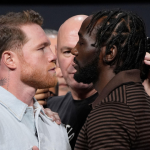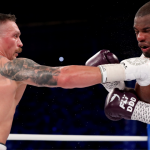VASYL Lomachenko hardly came out of nowhere. His amateur record was well known and appreciated, and by the time he made his professional debut he was considered one of the most accomplished amateur boxers of all time. But when compared to the development cycle of the usual Olympic medalist turned pro, Lomachenko arrived before many even knew he was coming. It was remarkable when Jeff Fenech challenged for and won the world title in his sixteenth professional fight back in 1987. In 2014, Lomachenko challenged for a world title in his second professional outing and won one in his third.
Everything in traditional boxing management is “seasoning” and preparation and that is especially obvious when a promoter gets their hands on an Olympic medalist. They are already a national hero, and the money will come easily, but no one wants to rush the fighter and see them declared a bust at the first loss. So in developing a world-class amateur into a world title challenger there is a focus on getting the rounds in and on getting used to fighting without head guards, for more rounds, and for the judges’ feelings over a time frame rather than specific points scored.
Pete Rademacher is only fighter in history whose professional debut was a world title fight. pic.twitter.com/OEHUjgydz5
— Boxing Register (@BoxingRegister) July 23, 2016
It is always a balancing act though. You don’t want your fighter to be Pete Rademacher—who got starched by Floyd Patterson in a heavyweight title fight in his professional debut—but you don’t want them to be Audley Harrison either. Harrison managed to never reach his potential and turn the British Broadcasting Corporation off boxing for good by accepting a million-pound contract to pick his own “bum of the month”. Push a fighter too soon and you might ruin their potential and gate, push them too late and you will have used up all their best fights on plumbers and postmen.
Luke Campbell did not jump in at the deep end as Lomachenko did. He certainly didn’t have the four hundred-odd amateur bouts under his belt that Lomachenko did, but even then Lomachenko’s loss in his second pro fight to the rough house tactics of Orlando Salido might have completely derailed any other fighter in the same situation—Loma was still in some respects the victim of biting off too much, too soon. Campbell instead has had the best of the traditional transition: he has built his name and confidence against some no-hopers, he has been strategically tested by tricky individuals, and when he found his way into a fight with Lomachenko’s great rival, Jorge Linares, Campbell gave a terrific account of himself.
Linares dropped Campbell early and this seemed to shake Campbell out of his cautious state.
But being pleasantly surprised by the Linares fight hasn’t made fight fans any more optimistic about Campbell’s chances against Lomachenko. There are a few red flags out there already even if you ignore Lomachenko’s almost superhuman boxing ability. Firstly, Campbell has had a lot of trouble in being consistently put on the back foot. This was true against Linares but this was especially obvious in his fights with Yvan Mendy. Mendy is good and tough, but his strategy was simply to put on his earmuffs and walk Campbell down. For the early going, Campbell did all the classy pot shotting and turning that he was supposed to, but he slowed down obviously and began standing in front of Mendy for longer and longer periods.
A second issue is that Campbell’s hand speed is decent but not remarkable. Against most boxers that isn’t a big deal but Linares was able to do much of his best work early as his combinations came in too fast and too hard, and flustered Campbell to the point that he couldn’t counter effectively. Campbell weathered the storm admirably and the speed disparity evened itself out somewhat as the fight progressed, but that isn’t a great indicator against the genuinely dazzling hand speed of Lomachenko. And a third issue is that while Campbell’s record has a healthy number of knockouts, he isn’t a great hitter—which is at this point one of the few criteria fans look for in a Lomachenko opponent because they suspect Lomachenko will be out-landing them at a good clip.
There are a couple of interesting change-ups here though. The southpaw vs southpaw match up is always an intriguing one. Both men are used to being exotic and are forced to fight a little more “orthodox”. For instance, Campbell’s lead shoulder and usually high lead arm should keep him a little safer from Lomachenko’s piston of a left straight.
The left straight is easily one of Lomachenko’s most powerful weapons.
Both men also love the long left uppercut to the body. This is because against an orthodox opponent their left-hand sweeps into the large unguarded space of the open side and they have a good amount of space to register and avoid the return off the same side. Against a fighter in the same stance, long rear handed body shots often hit the elbow and leave the fighter very exposed to taking the shorter lead hook on the same side.
If you saw Lomachenko’s last fight—a four-round beating of Anthony Crolla—you will remember that he applied tremendous pressure, backed Crolla onto the ropes, and then dropped back and to his left when Crolla lashed out. This is a common southpaw vs orthodox tactic to stretch out the opponent’s right hand and then fire the left hand over the top. And of course, Lomachenko is famous for sliding down the outside of the lead foot of orthodox opponents, dancing a circle around them while getting off blows. Lomachenko also has cool counters for his opponents trying to step down the outside of his lead foot, including a double footed hop that might be the payoff from those years of Ukranian folk dance that we are told about every single time he fights. But all of that is moot against another southpaw.
Just take a look at how fast Lomachenko takes away Crolla’s outside angle and gets his lead foot back on the outside.
In a southpaw vs southpaw matchup you can typically expect more work with the lead hand from both men. Lomachenko’s jab is spectacular, and Campbell’s is respectable. Lomachenko also tends to lean on the right hook a bit more against southpaws. One of Campbell’s better blows is a right hook to the body and against orthodox fighters, he is forced to try and sneak behind the elbow. More often he uses this blow to turn his opponents as he pivots past their lead foot. Against Lomachenko that right hook could be straightened up a bit and used as a short right to the solar plexus to slow Lomachenko down. Of course, that relies on Campbell being able to do so without getting paralysed by Lomachenko’s feints and speed.
Campbell isn’t being given much of a chance here but while he hasn’t always looked like a world-beater, upping the level of competition has always pleasantly surprised and brought a better fighter out of him. In Campbell’s worse performances he gets a little hesitant to free his hands from his guard and throw the crisp counters that he has, but after Linares dropped him on his arse in the early going of that fight it seemed like Campbell became braver and fought better as a result. If Campbell can stay out of his own head—or Lomachenko can punch him out of it—and actually open up, his economical style might help him get to Lomachenko in the later rounds once the Ukranian dancing machine slows down a little. That is, of course, if Campbell can get to those later rounds though.



